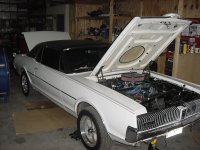A word of caution. The ign wire to the coil is a resistance wire reducing the voltage to 9v in a breaker system. The wire for the electronic ignition is not resistance and delivers 12v. I learned this the hard way when I switched one from electronic to breaker back in the mid 70's.
A friend had a dodge of some sort, I don't remember which one, and it had the breakerless distributor. It quit working and, since we were in Germany, he couldn't find any parts for it. He was getting close to coming back to the states so I told him we could probably get a breaker type from the junk yard and make it work. Then, when he got it back to the states, he could get the original distributor repaired and put back in.
It worked like a champ for about two days, then the points burned up. Too much voltage. I went back to the junk yard, got a ballast resistor off a Mercedes and put it on. Worked like a champ and he was able to get the car shipped back home a few weeks later. I showed him what I did so he could show the mechanic in the US what to take back off when he fixed it.
I caught up with him a couple of years later at Ft Leonard Wood and darned if he wasn't driving the same car with the breaker ignition and Mercedes resistor still on it. I asked him why he didn't get the original distributor put back in and he said if it ain't broke, don't fix it.
You will have the opposite problem replacing a breaker ignition with an OEM breakerless system. You won't have enough voltage and the spark plugs will fire weak. Possibly causing the engine to run rough and not idle well. Not sure if that will be a problem with an after market system. Probably not since they will be designed for your application.



